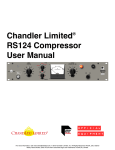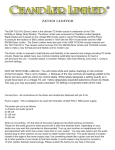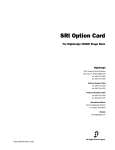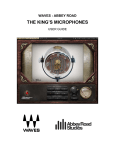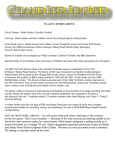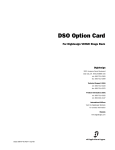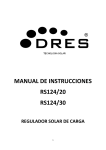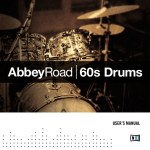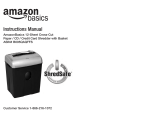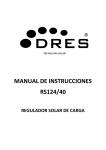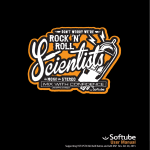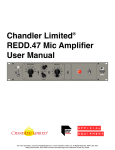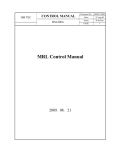Download RS124 Manual - Gear
Transcript
RS124 Compressor Plug-in User’s Guide TDM / RTAS / AU / VST – – AbbeyRoad www.abbeyroadplugins.com Copyright – Copyright 2010 EMI (IP) Limited All trademarks are property of their respective owners. EMI, ABBEY ROAD and RS124 are trademarks of EMI (IP) Limited Abbey Road Studios www.abbeyroadplugins.com www.abbeyroad.com Email: [email protected] Credits – Product Development: Abbey Road Studios and Cool Stuff Labs, Inc. GUI and Programming: Cool Stuff Labs, Inc. Documentation: Abbey Road Studios 02 01 – Introduction 04 02 – Installation and Authorisation 06 03 – User Interface and Controls 08 04 – Technical Notes 12 03 01 – Introduction There is a tradition of audio signal processing at Abbey Road that can be likened to a family tree. Over the generations skilled engineers have developed a whole range of equipment that we have used “in house” including the revered RS124. This valve compressor followed in the footsteps of the RS98 and RS114 and along with the design refinements it evolved into a device with unparalleled sound quality. These units were used exclusively at Abbey Road and unlike other EMI technology, the RS124 was not mass produced. The units we have at the studio today are unique and rare which has been one of the compelling reasons for spending significant resources to make our plug-in version as authentic as possible. These look, sound and smell like the originals! I am very excited about this release. I have the privilege at Abbey Road to use the original hardware and in all my years of recording and mixing I have not heard anything quite like these compressors. If I could describe the sound of pure cream being drizzled slowly into and over a mix, then this might start to say something about the velvety and liquid rich sound of compression that the RS124 is known for. Also, as these units were hand built, each of them were different by design. There was never any definitive “this is it” end stop with their use. The technical engineers at Abbey Road kept tinkering with various tweaks , modifying and experimenting to determine which one might sound better. Thus the three RS124s I use today are all slightly different; another reason why I am excited about this plug-in release. We have modelled all three units and have created one of the only genuine LCR plug-ins, a boon for those who record and mix for film scores. I have had the amazing opportunity to remix Beatles and Lennon master tapes and know how good these compressors sounded in the 60’s which is why I love using them today. Good gear stands the test of time and I hope these plug-in versions bring much satisfaction to creative productions in our new digital era. Peter Cobbin Director of Engineering Abbey Road Studios March 2010 04 About the Plug-In About the Plug-in – The RS124 Compressor Plug-In is a faithful digital recreation of EMI’s legendary tube compressor, which was the primary compressor used at Abbey Road throughout the ‘60s. The original hardware was made in very limited numbers and the plug-in brings the sound of this highly-prized, rare unit to modern digital audio workstations. Compatibility – The RS124 Compressor Plug-in is compatible with all popular DAW host applications for Mac OS X and Windows XP/Vista. The plug-in is actually three plug-ins in one, providing three different versions of the RS124 compressor which have been modelled on three vintage Abbey Road hardware units. The compression behaviour and sonic characteristics of three vintage units has been recreated in the plug-in and much effort was made to capture the nuances of each unit. The visual appearance of the original hardware units has also been reproduced in the software. System Requirements – TDM - Pro Tools HD 7.0 or higher Native – Any AU, VST or RTAS compatible host application (Pro Tools 7.0 or higher for RTAS) It supports sample rates up to 192kHz and can be used on mono, multi-mono and stereo tracks. In addition, Pro Tools HD users can also use the RS124 on LCR tracks. Mac OS 10.4 or higher on a PPC or Intel CPU Windows XP or Vista on a P4 CPU (or higher) iLok USB key and the latest iLok drivers (available from http://www.ilok.com) The three RS124 versions are identified in the plug-in by the serial number of the hardware unit on which they are based and every aspect of the hardware behaviour has been recreated in the plug-in. Each of the three versions in the plug-in provides the gain reduction curve, attack/release behaviour and dynamic frequency response from the vintage hardware and every parameter in the plug-in has been specifically tailored to match the behaviour of the individual hardware units. 05 02 – Installation and Authorisation Installation – To Install the RS124 plug-in: 1/ Go to www.abbeyroadplugins.com/downloads.aspx and download the correct installer for your system, i.e. TDM for Pro Tools HD, AU for Logic Pro, etc. Authorising – Authorising at www.ilok.com 1/ Make sure that the Plug-in has been installed as outlined in ‘Installation’ above and the latest iLok drivers have been installed on your system. 2/ Insert your iLok key into an available USB port on your computer and log in to your account at http://www.ilok.com. 2/ When the download has been completed, double-click the downloaded file to unpack the installer. 3/ Once logged in, you will see a message saying ‘You have a new license available’. Click the ‘Download to iLok’ link next to this. 3/ Double-click the installer and follow the instructions on-screen. The installer will place the plug-in into the appropriate folder on your system. 4/ Click the ‘Download to iLok’ button at the bottom of the page. This will transfer the RS124 Compressor Plug-in license to the iLok key and authorise it. If you experience any difficulties with the iLok license download procedure, please see the support information at http://www.ilok.com/ilok-faq.html. 06 Technical Support – Technical support is available online. You can submit a question in the Support area of our website at www.abbeyroadplugins.com or email us at: [email protected] The latest Plug-in versions, product news and answers to common questions (FAQs) are also available from the website. 07 03 – User Interface and Controls 60050A – Model Selector Recovery / Hold Meter Output Attenuator Input Control Balance Lamp SuperFuse Power 61010B – Model Selector Recovery / Hold Meter Output Attenuator Input Control Balance Lamp SuperFuse Power 60070B – Model Selector Balance Recovery / Hold Meter Lamp Output Attenuator Input Control 08 SuperFuse Power Model Selector – The Model Selector is used to switch between the three models. the original RS124 Compressor hardware in response to two scenarios faced by EMI engineers when large amounts of gain reduction were being applied: Clicking on the serial number label on the left of the faceplate opens a pop-up menu. From this you can select one of the three models by serial number: 60050A, 61010B or 60070B. 1/ When trying to process the initial attack of an audio track, the slow attack of the compressor would cause an audible thump to be produced. The Hold control would be used in these cases to “prime” the compressor with the required amount of gain reduction and prevent the thump from occurring. When a selection is made in the menu, the signal processing will change accordingly to give the compression behaviour of the chosen unit. The graphics will also change to match the new selection. This was done by playing a track into the compressor, setting the controls as required and then moving the Recovery control to one of the adjacent Hold positions. This would prevent the compressor release taking place and maintain the amount of gain reduction. The attack and release times in model 60070B are approximately three times faster than those of the others, so provides a more audible compression effect. You may find that models 60050A and 61010B are more suitable for bus or mix compression and model 60070B more suited to channel compression. The tape deck would then be stopped, rewound to the beginning of the track and playback started again. Once the initial attack of the first note had been processed, the RS124 Compressor could be switched out of Hold and put back to the desired Recovery setting. Recovery / Hold – Recovery The Recovery control sets the release time of the compressor. 2/ If the unit was compressing a track with room ambience, the ambient noise from the recording would swell up in volume at the end of the performance as the gain reduction returned from the compressed level to zero. There are six Recovery positions labelled 1 (Fast) to 6 (Slow). The six release times are different in the three models, therefore the release time given depends on which unit has been selected with the Model Selector. This could be avoided by switching the Recovery control to an adjacent Hold position after the last note had finished, which would stop the compressor release taking place. Hold The Hold function is a unique feature of EMI compressors. It was added as a modification on 09 Meter – The meter displays how much gain reduction is being applied. When the Recovery control is moved to one of the red Hold positions, the Plug-in functions in the same way as the hardware, preventing the compressor release and maintaining the amount of gain reduction. In practice, the RS124 Compressor Plug-in is set to a very, very long release time. The meter range, 0 to 30dB, is the same as the original hardware. The calibration of the meter is unique to each model and has been recreated from the modelled hardware units. Balance – When the Hold function is in use and the input signal is removed, pressing the Balance button inwards activates the compressor’s release and the meter will move back towards the zero position. This allows you to set the level of gain reduction the compressor is “primed” with. Output Attenuator (dB) – The Output Attenuator provides level attenuation after the gain reduction stage. It is a six-position control giving up to 30dB of attenuation. The default position is 0dB. The next four positions attenuate in 5dB steps with the last step attenuating by a further 10dB . When set to one of the six Recovery positions, the Balance button has no effect. Input Control – The Input Control determines how much compression is applied to the input signal. SuperFuse – SuperFuse is not a feature of the original EMI hardware but has been included as an extra feature to enhance the sonic potential of the RS124 Compressor Plug-in. It functions both as an input gain and a reverse threshold control, boosting the signal level and providing more compression as it is turned up. It has a range of 0 to 10, with 10 providing maximum gain and compression. Clicking on the fuse holder toggles the SuperFuse mode on and off. When turned on, the fuse holder and lamp turn red. SuperFuse sets the compressor’s release time to match its attack time. The effect is slightly different in the three models because of their different attack times, but it gives a more punchy and overcompressed effect. Depending on the level of the input signal, you may find that the Input Control and Output Attenuator need to be used together to prevent clipping in the Plug-in. When SuperFuse is active the setting of the Recovery control is ignored, but all other controls operate as normal. 10 Power – The Power switch turns the compressor on and off but operates independently of the Plug-in’s master bypass. Adjusting Controls – The RS124 Compressor Plug-in controls may be adjusted in the following ways: • Click and drag up/to the right to increase a control setting, or drag down/to the left to decrease. When using the RS124 Compressor Plug-in on Stereo or LCR tracks in Pro Tools, this switch allows the compression on each channel to be turned on and off individually. See ‘Stereo and LCR Operation in Pro Tools’ below for more details. • By clicking on any of the label markings around the control to go instantly to a setting. • Using any supported external control surface. Lamp – The lamp gives a visual indication of the Plug-in status: To reset a control to its default setting: • Option-click (on Mac OS X) or Alt-click (on Windows) the control. White = Normal compression Red = SuperFuse compression Off = Compression off 11 04 – Technical Notes Stereo and LCR Operation in Pro Tools – When using AU and VST versions on a stereo track, the Plug-in uses a single set of controls to set the compression. In TDM and RTAS versions, a dedicated stereo interface is provided with two sets of controls. This allows the user to select the model applied to each channel. The On/Off controls operate independently on each channel, with the master bypass at the top of the Plug-in window overriding the position of the On/Off controls. A dedicated LCR interface is available in Pro Tools HD which provides three sets of RS124 Compressor Plug-in controls. As with the stereo operation outlined above, the model applied to each channel can be individually selected and the gain reduction calculated from a combination of the three channels, as if three physical units had been linked together. The gain reduction is calculated from a combination of the left and right channels, just as if two physical RS124 Compressor units were being used with their hardware link engaged. The controls on both channels should be set to the same positions to maintain the stereo image of the signal. The controls on each channel operate independently by default, but can be operated together by holding down the Shift key (Mac) or Alt key (Windows) when moving a control or clicking on a control label. 12 DSP Usage with Pro Tools HD – The table below shows the theoretical maximum number of RS124 Compressor instances supported on Core and Accel DSPs. The figures show the number of instances that can fit on one DSP chip at different sample rates and the total usage of that DSP. Note: 176.4 and 192kHz sample rates are not supported on Core DSPs. 44.1/48kHz 88.2/96kHz 176.4/192kHz Accel DSP: Mono : Stereo: LCR: 10 96% 5 92% 3 82% 4 81% 2 78% 1 60% 2 89% 1 86% - - Core DSP: Mono : Stereo: LCR: 4 88% 2 85% 1 64% 2 95% 1 92% - - - - - - TDM Insert Delay: 2 samples MultiShell Delay: 2 samples Delay due to processing inside the Plug-in: 0 samples www.abbeyroadplugins.com – 13














